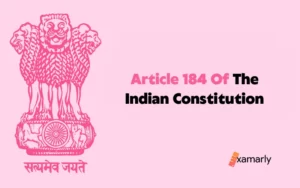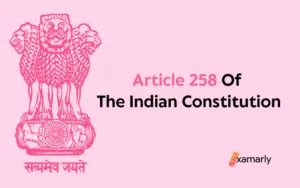The 40th Amendment of Indian Constitution is officially known as The Constitution (Fortieth Amendment) Act, 1976. In addition to 64 central laws in the ninth schedule, this constitutional amendment also includes measures relating to maritime zones and EEZs. T
Read this article further to learn more about the changes done by the 40th amendment of the Indian Constitution. This will be worth reading for you if you are preparing for a competitive examination like UPSC. This is included in the Indian Polity of UPSC Syllabus.
What Is The 40th Amendment Of Indian Constitution?
On 27 May 1976, this major amendment came into effect. This constitutional amendment modifies article 297 and the 9th schedule of the constitution. When this modification was approved, Indira Gandhi was the prime minister.
- This amendment gave the Parliament the power to periodically specify the boundaries of India’s continental shelf, territorial seas, exclusive economic zone (EEZ), and marine zones.
- This added 64 more Central and state laws to the 9th Schedule, most of which dealt with land reforms.
Salient Features And Facts
| When was it Introduced? | In the Lok Sabha on 21 May 1976, |
| The official name of the Amendment | The Constitution (Fortieth Amendment) Act, 1976 |
| Which articles were amended? | Article 297 |
| Which Schedules were amended? | Schedule 9 |
Object And Reason Behind The Amendment
The Constitution (Forty-second Amendment) Bill, 1976 which became the Constitution (Fortieth Amendment) Act, 1976, had a statement of purposes and justifications attached to it.
According to Article 297 of the Constitution, the Union of India is entitled to hold for the benefit of the Union all lands, minerals, and other valuable resources beneath the ocean in India’s territorial waters or continental shelf. The resources in the exclusive economic zone are within India’s sovereign rights. Furthermore, is permitted to exercise jurisdiction over a number of additional issues in that zone. The amendment of Article 297 of the Constitution is being considered. This is done to make sure that the Union owns and is in possession of all lands, minerals, and valuable objects under the ocean that are located in India’s exclusive economic zone as well as all other resources inside that zone. The President’s proclamation currently in effect sets the boundaries of the continental shelf and the territorial waters. It is suggested that Parliamentary law set periodic borders for India’s territorial waters, continental shelf, exclusive economic zone, and marine zones.
Every time it was discovered that progressive legislation planned in the public interest was in jeopardy by litigation, recourse was had to the Ninth Schedule in the past. The Ninth Schedule already contains a number of State laws dealing with land reform and agricultural land holdings. The provisions of article 31B must also require protection in relation to some changes made to these laws. Because these laws have frequently been challenged in court and the national land reform policy has been difficult to implement as a result of interim reliefs that the courts have also given.
Along with these land reform laws, certain state laws dealing with private forests also need the protection of article 31B. Because these laws are useful and progressive laws designed to break the monopoly of vested interests and forest contractors. The State Governments have been unable to put some of these laws into effect because the courts have given interim reliefs that have prevented these enactments from taking effect.
The protection of article 31B is required by a number of Central laws. These include the Smugglers and Foreign Exchange Manipulators (Forfeiture of Property) Act of 1976, the Urban Land (Ceiling and Regulation) Act of 1976, the Essential Commodities Act of 1955 and a few sections of the Motor Vehicles Act of 1939. The many goals of enacting these laws would be disappointing, and the national economy may suffer, if it is permitted for these legislations to be contested in court, delaying their implementation. It is suggested that the Ninth Schedule contain these and other significant and unique laws that should have constitutional Protection.
The Bill aims to accomplish the aforementioned goals.
See Also – 41st Amendment Of Indian Constitution
Important Provisions
Substitution of new article for article 297– The following article shall be replaced for Article 297 of the Constitution, namely:-
“297. Resources in the exclusive economic zone and valuable items found in territorial water or the continental shelf vest in the Union.
(1)All lands, minerals, and valuable items under the ocean that are located inside India’s territorial waters, continental shelf, or exclusive economic zone shall belong to the Union and be held for the benefit of the Union of India.
(2)All additional resources in India’s exclusive economic zone must belong to the Union and be retained therein for its objectives.
(3)The exclusive economic zone, continental shelf, and other maritime zones of India shall be bounded by or in accordance with any law passed by Parliament from time to time.
Amendment of the Ninth Schedule-The following entries shall be included in the Ninth Schedule to the Constitution, after entry 124 and before the Explanation, namely:
“125. Section 66A and Chapter IVA of the Motor Vehicles Act, 1939 (Central Act 4 of 1939).
126. The Essential Commodities Act, 1955 (Central Act 10 of 1955).
127. The Smugglers and Foreign Exchange Manipulators (Forfeiture of Property) Act, 1976 (Central Act 13 of 1976).
128. The Bonded Labour System (Abolition) Act, 1976 (Central Act 19 of 1976).
129. The Conservation of Foreign Exchange and Prevention of Smuggling Activities (Amendment) Act, 1976 (Central Act 20 of 1976).
130. The Prevention of Publication of Objectionable Matter Act, 1976 (Central Act 27 of 1976).
131. The Levy Sugar Price Equalisation Fund Act, 1976 (Central Act 31 of 1976).
132. The Urban Land (Ceiling and Regulation) Act, 1976 (Central Act 33 of 1976).
133. The Departmentalisation of Union Accounts (Transfer of Personnel) Act, 1976 (Central Act 59 of 1976).
134. The Assam Fixation of Ceiling on Land Holdings Act, 1956 (Assam Act I of 1957).
135. The Bombay Tenancy and Agricultural Lands (Vidarbha Region) Act, 1958 (Bombay Act XCIX of 1958).
136. The Gujarat Private Forests (Acquisition) Act, 1972 (Gujarat Act 14 of 1973).
137. The Haryana Ceiling on Land Holdings (Amendment) Act, 1976 (Haryana Act 17 of 1976).
138. The Himachal Pradesh Tenancy and Land Reforms Act, 1972 (Himachal Pradesh Act 8 of 1974).
139. The Himachal Pradesh Village Common Lands Vesting and Utilisation Act, 1974 (Himachal Pradesh Act 18 of 1974).
140. The Karnataka Land Reforms (Second Amendment and Miscellaneous Provisions) Act, 1974 (Karnataka Act 31 of 1974).
141. The Karnataka Land Reforms (Second Amendment) Act, 1976 (Karnataka Act 27 of 1976).
142. The Kerala Prevention of Eviction Act, 1966 (Kerala Act 12 of 1966).
143. The Thiruppuvaram Payment (Abolition) Act, 1969 (Kerala Act 19 of 1969).
144. The Sreepadam Lands Enfranchisement Act, 1969 (Kerala Act 20 of 1969).
145. The Sree Pandaravaka Lands (Vesting and Enfranchisement) Act, 1971 (Kerala Act 20 of 1971).
146. The Kerala Private Forests (Vesting and Assignment) Act, 1971 (Kerala Act 26 of 1971).
147. The Kerala Agricultural Workers Act, 1974 (Kerala Act 18 of 1974).
148. The Kerala Cashew Factories (Acquisition) Act, 1974 (Kerala Act 29 of 1974).
149. The Kerala Chitties Act, 1975 (Kerala Act 23 of 1975).
150. The Kerala Scheduled Tribes (Restriction on Transfer of Lands and Restoration of Alienated Lands) Act, 1975 (Kerala Act 31 of 1975).
151. The Kerala Land Reforms (Amendment) Act, 1976 (Kerala Act 15 of 1976).
152. The Kanam Tenancy Abolition Act, 1976 (Kerala Act 16 of 1976).
153. The Madhya Pradesh Ceiling on Agricultural Holdings (Amendment) Act, 1974 (Madhya Pradesh Act 20 of 1974).
154. The Madhya Pradesh Ceiling on Agricultural Holdings (Amendment) Act, 1975 (Madhya Pradesh Act 2 of 1976).
155. The West Khandesh Mehwassi Estates (Proprietary Rights Abolition, etc.) Regulation, 1961 (Maharashtra Regulation (1 of 1962).
156. The Maharashtra Restoration of Lands to Scheduled Tribes Act, 1974 (Maharashtra Act XIV of 1975).
157. The Maharashtra Agricultural Lands (Lowering of Ceiling on Holdings) and (Amendment) Act, 1972 (Maharashtra Act XXI of 1975).
158. The Maharashtra Private Forests (Acquisition) Act, 1975 (Maharashtra Act XXIX of 1975).
159. The Maharashtra Agricultural Lands (Lowering of Ceiling on Holdings) and (Amendment) Amendment Act, 1975 (Maharashtra Act XLVII of 1975).
160. The Maharashtra Agricultural Lands (Ceiling on Holdings) (Amendment) Act, 1975 (Maharashtra Act II of 1976).
161. The Orissa Estates Abolition Act, 1951 (Orissa Act I of 1952).
162. The Rajasthan Colonisation Act, 1954 (Rajasthan Act XXVII of 1954).
163. The Rajasthan Land Reforms and Acquisition of Land-owners’ Estates Act, 1963 (Rajasthan Act 11 of 1964).
164. The Rajasthan Imposition of Ceiling on Agricultural Holdings (Amendment) Act, 1976 (Rajasthan Act 8 of 1976).
165. The Rajasthan Tenancy (Amendment) Act, 1976 (Rajasthan Act 12 of 1976).
166. The Tamil Nadu Land Reforms (Reduction of Ceiling on Land) Act, 1970 (Tamil Nadu Act 17 of 1970).
167. The Tamil Nadu Land Reforms (Fixation of Ceiling on Land) Amendment Act, 1971 (Tamil Nadu Act 41 of 1971).
168. The Tamil Nadu Land Reforms (Fixation of Ceiling on Land) Amendment Act, 1972 (Tamil Nadu Act 10 of 1972).
169. The Tamil Nadu Land Reforms (Fixation of Ceiling on Land) Second Amendment Act, 1972 (Tamil Nadu Act 20 of 1972).
170. The Tamil Nadu Land Reforms (Fixation of Ceiling on Land) Third Amendment Act, 1972 (Tamil Nadu Act 37 of 1972).
171. The Tamil Nadu Land Reforms (Fixation of Ceiling on Land) Fourth Amendment Act, 1972 (Tamil Nadu Act 39 of 1972).
172. The Tamil Nadu Land Reforms (Fixation of Ceiling on Land) Sixth Amendment Act, 1972 (Tamil Nadu Act 7 of 1974).
173. The Tamil Nadu Land Reforms (Fixation of Ceiling on Land) Fifth Amendment Act, 1972 (Tamil Nadu Act 10 of 1974).
174. The Tamil Nadu Land Reforms (Fixation of Ceiling on Land) Amendment Act, 1974 (Tamil Nadu Act 15 of 1974).
175. The Tamil Nadu Land Reforms (Fixation of Ceiling on Land) Third Amendment Act, 1974 (Tamil Nadu Act 30 of 1974).
176. The Tamil Nadu Land Reforms (Fixation of Ceiling on Land) Second Amendment Act, 1974 (Tamil Nadu Act 32 of 1974).
177. The Tamil Nadu Land Reforms (Fixation of Ceiling on Land) Amendment Act, 1975 (Tamil Nadu Act 11 of 1975).
178. The Tamil Nadu Land Reforms (Fixation of Ceiling on Land) Second Amendment Act, 1975 (Tamil Nadu Act 21 of 1975).
179. Amendments were made to the Uttar Pradesh Zamindari Abolition and Land Reforms Act, 1950 (Uttar Pradesh Act I of 1951) by the Uttar Pradesh Land Laws (Amendment) Act, 1971 (Uttar Pradesh Act 21 of 1971), and the Uttar Pradesh Land Laws (Amendment) Act, 1974 (Uttar Pradesh Act 34 of 1974).
180. The Uttar Pradesh Imposition of Ceiling on Land Holdings (Amendment) Act, 1976 (Uttar Pradesh Act 20 of 1976).
181. The West Bengal Land Reforms (Second Amendment) Act, 1972 (West Bengal Act XXVIII of 1972).
182. The West Bengal Restoration of Alienated Land Act, 1973 (West Bengal Act XXIII of 1973).
183. The West Bengal Land Reforms (Amendment) Act, 1974 (West Bengal Act XXXIII of 1974).
184. The West Bengal Land Reforms (Amendment) Act 1975 (West Bengal Act XXIII of 1975).
185. The West Bengal Land Reforms (Amendment) Act, 1976 (West Bengal Act XII of 1976).
186. The Delhi Land Holdings (Ceiling) Amendment Act, 1976 (Central Act 15 of 1976).
187. The Goa, Daman, and Diu Mundkars (Protection from Eviction) Act, 1975 (Goa, Daman, and Diu Act 1 of 1976).
188. The Pondicherry Land Reforms (Fixation of Ceiling on Land) Act, 1973 (Pondicherry Act 9 of 1974).”.
Conclusion
The 40th Amendment went into effect on 27 May 1976. This constitutional amendment gave the Parliament the power to periodically define India’s territorial seas, continental shelf, exclusive economic zone (EEZ), and maritime zones.






